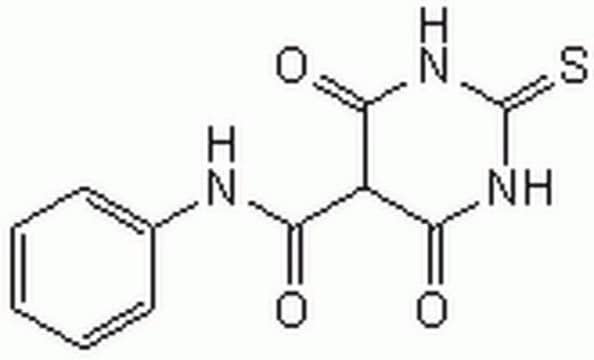M2070
Merbarone
≥98% (HPLC), solid
Sinónimos:
5-(N-Phenylcarbamoyl)-2-thiobarbituric acid, NSC-336628
About This Item
Productos recomendados
Análisis
≥98% (HPLC)
formulario
solid
control farmacológico
regulated under CDSA - not available from Sigma-Aldrich Canada
solubilidad
DMSO: >5 mg/mL
temp. de almacenamiento
2-8°C
cadena SMILES
O=C1NC(=S)NC(=O)C1C(=O)Nc2ccccc2
InChI
1S/C11H9N3O3S/c15-8(12-6-4-2-1-3-5-6)7-9(16)13-11(18)14-10(7)17/h1-5,7H,(H,12,15)(H2,13,14,16,17,18)
Clave InChI
JARCFMKMOFFIGZ-UHFFFAOYSA-N
Aplicación
Acciones bioquímicas o fisiológicas
Código de clase de almacenamiento
11 - Combustible Solids
Clase de riesgo para el agua (WGK)
WGK 3
Punto de inflamabilidad (°F)
Not applicable
Punto de inflamabilidad (°C)
Not applicable
Equipo de protección personal
Eyeshields, Gloves, type N95 (US)
Certificados de análisis (COA)
Busque Certificados de análisis (COA) introduciendo el número de lote del producto. Los números de lote se encuentran en la etiqueta del producto después de las palabras «Lot» o «Batch»
¿Ya tiene este producto?
Encuentre la documentación para los productos que ha comprado recientemente en la Biblioteca de documentos.
Artículos
Agents reported to activate cellular caspases include chemotherapeutic drugs, TNF receptor agonists, and other enzymes. Inhibitors of apoptosis were the first identified endogenous caspase inhibitors.
Nuestro equipo de científicos tiene experiencia en todas las áreas de investigación: Ciencias de la vida, Ciencia de los materiales, Síntesis química, Cromatografía, Analítica y muchas otras.
Póngase en contacto con el Servicio técnico








